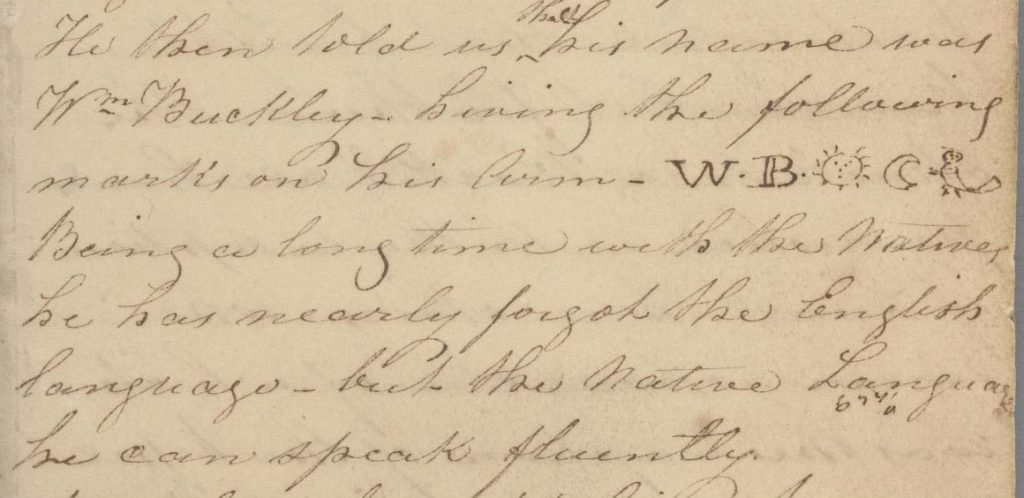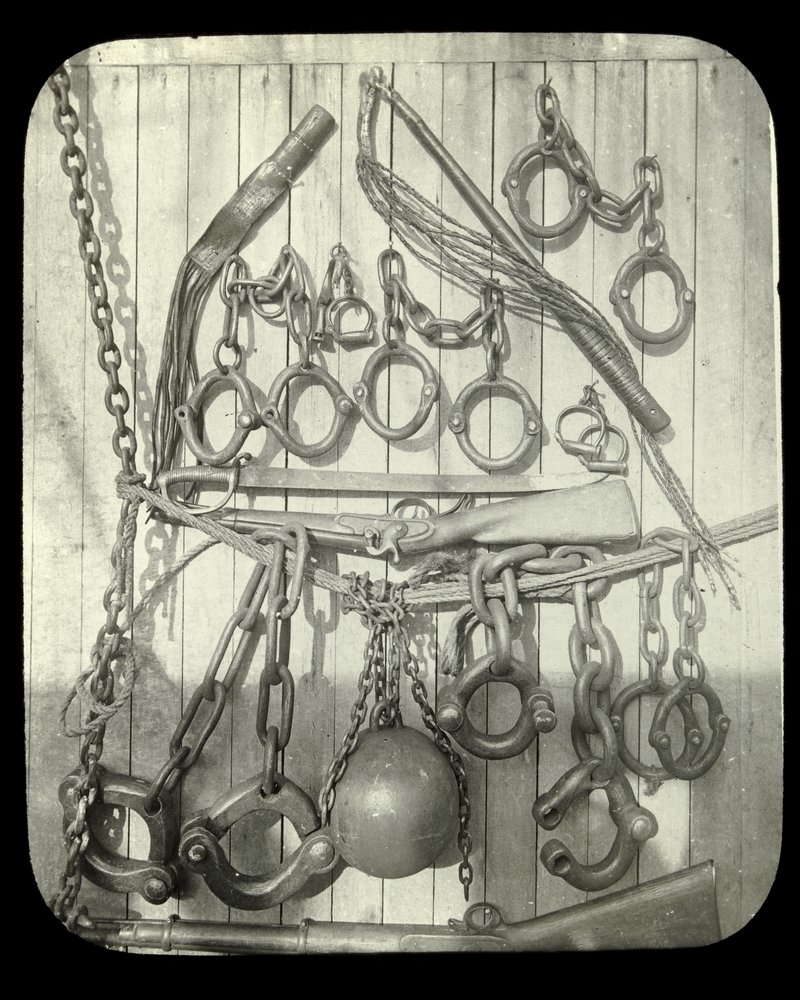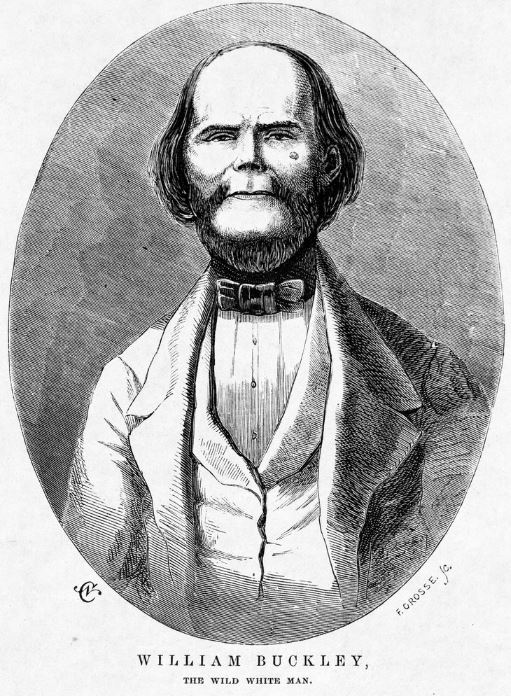Around a quarter of convicts who were sent to Australia had at least one tattoo. The most famous example was William Buckley – the British convict who escaped a penal settlement and lived with the Wathaurong tribe for 32 years. Buckley had multiple tattoos, including a sun, a half moon, seven stars and a monkey, as well as his initials, tattooed on his lower arm [1].
William Buckley. The wild white man; NLA00/08/57/00
When Buckley finally surrendered to John Batman’s men at Indented Head, he wore ‘an enormous opossum skin rug … his hair and beard spread out as large as a bushel measure’ (Colonial Times, 25 August 1835 p. 6). He had lived for so long in the bush that he had lost the ability to speak in his mother tongue. He identified himself by pointing to the initials tattooed on his arm. The men took guesses as to the meaning of the initials, until Buckley eventually burst out his name: ‘William Buckley.’
William Todd (John Batman’s recorder) later sketched a picture of Buckley’s tattoos in his journal:
 Excerpt from William Todd’s journal 6 July 1835, p. 26. This manuscript is in copyright.
Excerpt from William Todd’s journal 6 July 1835, p. 26. This manuscript is in copyright.
William Buckley’s tattoos were typical of many. Names and initials were predictably popular. So too were dates. Often, letters were combined with dates and symbols, so as to read as a kind of shorthand. The anchor, in particular, was used in this fashion. Scholars believe it was a symbol of hope.
Sydney Illustrated News, 15 November 1886, p. 8
The convict’s tattoos were unlike the tattoos of today. Mostly, they were blue or black in colour. They were created with gunpowder or charcoal. Indian ink and China-ink were also used [2]. It is thought that the method employed by the tattooist would have been similar to that of the Pacific Islanders, but with a needle or metal instrument, instead of a bone:
The Colour they use is lamp black prepared from the smook of a kind of Oily nutt… the Instruments for pricking it under the skin is made of very thin flat pieces of [b] one or shell… one end is cut into sharp teeth and the other fasten’d to a handle; the teeth are dipped into the black liquor and then drove by quick sharp blows … into the skin so deep that every stroke is followed [with] a small quantity of blood. [3]
 Tattooing in New Zealand; IAN19/05/66/12
Tattooing in New Zealand; IAN19/05/66/12
When a new convict arrived in a colony, a clerk would record his or her physical details in a ‘black book’, or register. Details recorded included: a person’s trade, height, age, complexion, head, hair, whiskers, visage, forehead, eyebrows, eyes, nose, mouth, chin, and ‘native place’. Other distinguishing characteristics or marks were recorded in the ‘Remarks’ column at the bottom of the page. It was here that the clerks would record a convict’s tattoos.
The variety of tattoos recorded in these books is astonishing. Along with the requisite anchors and hearts, there were mermaids, crucifixes, comets, suns, moons and stars, jewellery such as bracelets and finger rings, clusters of dots, roses, flowerpots, busts of men and women, cock fights, lovers knots, drinking glasses, pipes and jugs, and all manner of animals – bees, stags, doves, eagles, horses, lambs, seahorses, swans – to name a few.
 Convict ship Success a century ago; H99.220/721
Convict ship Success a century ago; H99.220/721
Often, tattoo designs were confined to a particular ship. In 1828, five convicts from the ship Woodford disembarked with tattoos of a beehive. Eighteen men from the Moffatt bore tattoos of a willow tree, while sixteen men from the ship Lotus were tattooed with the bust of a woman.[4] More than a dozen convicts who arrived in Hobart aboard the ship Equestrian II were adorned with the same tattoo of the crucifixion, seven stars, and four candlesticks. Whilst seven stars and seven candlesticks are depicted in bible‘s book of Revelations, four candlesticks made no sense to scholars at all. [5]
 Relics of convict discipline; H37687/4
Relics of convict discipline; H37687/4
Convict tattoos are a fascinating study. Nineteenth century phrenologists saw tattoos as a sign of criminality, but in reality, they were so much more. For while a convict’s body could be shackled and beaten, their humanity remained elusive – immortalised in their tattoos.
References
[1] Atkinson, A., 1987, Footnote people in Australian history, Broadway, N.S.W.: Fairfax Library in association with Daniel O’Keefe Publishing, Broadway, N.S.W., p. 36
[2] Barnard, S., 2016, Convict tattoos: marked men and women in Australia, Melbourne, Victoria, Text Publishing Company, p. 8
[3] Cook, J., Beaglehole, J., & Skelton, R., 1955, The Journals of Captain James Cook on his voyages of discovery, vol 1, p. 125
[4] Barnard, op cit, p. 12
[5] Bradley, J. & Maxwell-Stewart, H., 1998, ‘The search for the convict voice’, Tasmanian Historical Studies, vol. 6, no. 1, p. 83




They were noted the same way in the ww1 records. Fascinating insight. Not decorator items like many today.
Thank you for your interesting post.
Danny
Great article! Thank you.
this is really fascinating! thanks for the post!
Interesting. My GG grandfather was a sea Captain of the Louisa Brigg. He had his initials on arm. If he was to fall overboard he may be identified if drowned at sea or washed up.